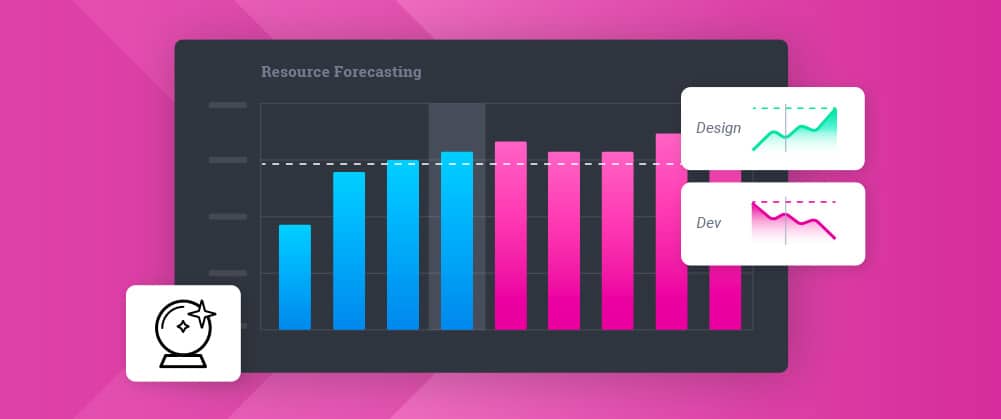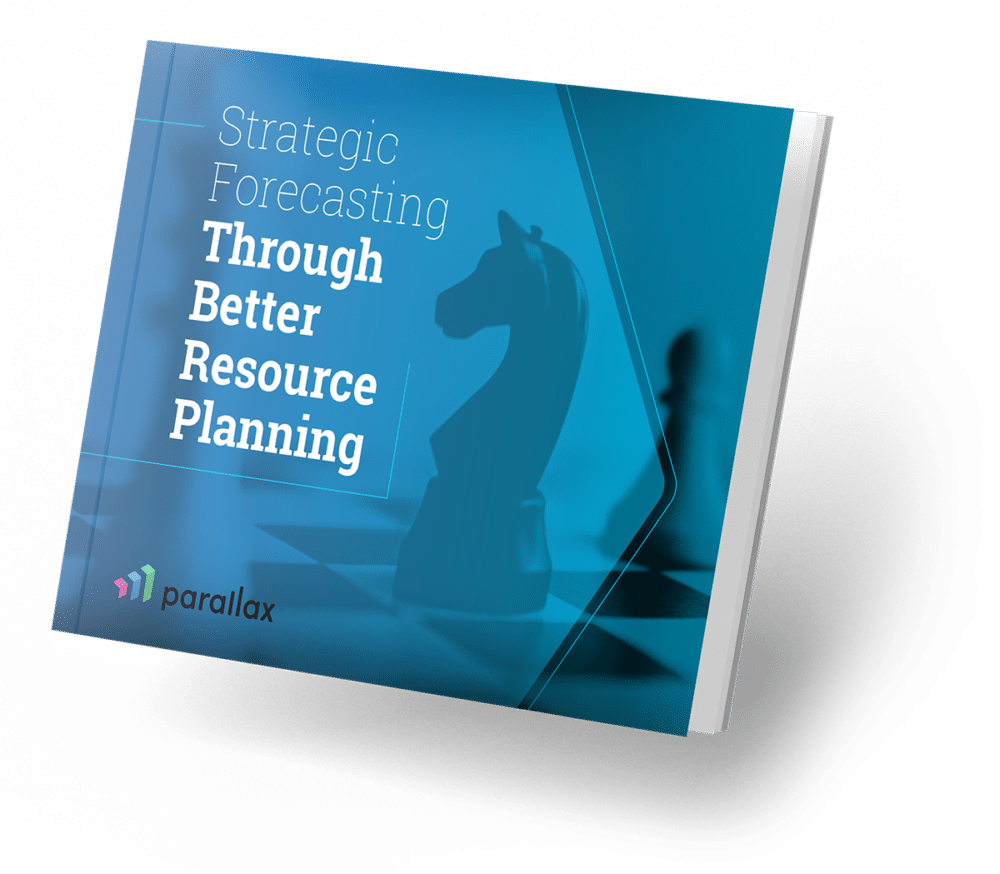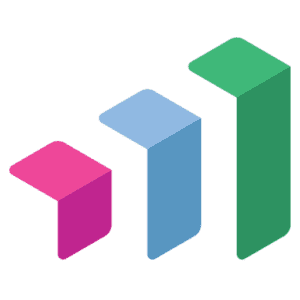Resource Forecasting Tools for Digital Agencies [Complete Guide]

Resource forecasting usually isn’t anyone’s favorite task. Leaders often approach resourcing meetings with dread and leave them feeling deflated—but it doesn’t need to be this way. Today’s solutions can serve up the exact information they need to make smart resourcing choices and help establish best practices and workflows that make forecasting a less stressful (maybe even fun? 👀) activity. Let’s dive in!
Table of Contents:
What is resource forecasting?
Resource forecasting vs. resource planning vs. resource management
The benefits of resource forecasting for digital agencies
Features to look for in resource forecasting tools
Top resource forecasting tools for your agency
How to choose the right resource forecasting software
What is resource forecasting?
Resource forecasting is essentially a balancing act where leaders and resource managers attempt to 1) bring in enough new business to hit revenue targets, 2) have the right amount of talent on staff to deliver quality results, and 3) keep everyone engaged and driven.
Did we mention this is a challenging balancing act? It’s one that often leads to reactive, instinctual actions rather than confident, data-informed decisions, but there is a way around the stressful ebb and flow of resource forecasting…
Reliable, real-time insights from a solution that’s designed specifically for resource planning and forecasting can reduce volatility by providing a clear, concise picture to leaders of what’s currently happening across every business function, what’s coming down the sales pipeline, and what they should consider doing to better balance the needs of the business with the needs of their people. When this clicks – when it all comes together to enable better resource planning AND active forecasting – operations are smoother, performance is enhanced, growth is possible, and everyone is happier.
Resource forecasting vs. resource planning vs. resource management
The services industry loves coming up with new terminology for best practices and processes, even using them interchangeably. And depending on which agency or software development shop you’re at, different phrases could mean slightly different things 🙃 – so let’s clear up what we mean at Parallax when we’re talking about everyone’s favorite activity:
- Resource forecasting: Demand for and profitability of services is always changing—resource forecasting involves leaders predicting where they should invest in resources to meet those changes, using current workloads and sales pipeline data to inform their predictions
- Resource planning: Leveraging said forecast to develop an actionable plan, assigning specific resources (i.e., talent) to specific projects
- Resource management: Monitoring progress of projects against resources, ensuring everything is on time and on budget + making real-time adjustments as needed
These are (clearly) nuanced best practices, but they’re all working towards the same thing: enabling smarter decision-making about the business and your people, all to ultimately help your organization evolve into a strategic operation, poised for innovation and growth.
The benefits of resource forecasting for digital agencies
Good resource forecasting, planning, and management is crucial to predicting and navigating anything else in the business. Resource forecasting informs your revenue and margin forecasts and is key to making confident decisions related to cash flow. It reduces reactive, rushed hiring and instead enables proactive, selective hiring. So many critical elements of the business hinge on successful resource forecasting—and when you get it right, magic happens ✨…
Achieve higher utilization
Every organization is tasked with optimizing and stabilizing utilization: the measurement of the team’s total time spent on billable work versus the total billable time available. Low utilization means team members aren’t meeting their billable targets and are spending more time than expected on internal or non-billable work or simply not having enough to do (which is no good for anyone). High utilization on the other hand indicates that an organization is efficiently using the capacity of its team and that everyone is meeting or exceeding their billable targets (which is great for everyone). Effective resource forecasting allows digital services organizations to achieve higher utilization, which allows them to more easily hit revenue targets.
Keep strong talent
Billable utilization isn’t a zero-sum game, meaning that you can’t offset low billable hours of some employees by expecting more from others to offset the overall shortage. But when there’s a lack of foresight that leads to reactive decisions, this is the common scenario we see play out: you put your best people on new work because they can be trusted to deliver, even if they are already busy. Strong talent steps up, balances work themselves, and completes the work—but keep in mind good, reliable, smart employees are likely more expensive, too, meaning you have cheaper employees doing less while expensive employees do more, which directly impacts profitability. This strategy also leads to the risk of over relying on your “A players” to step up. They’ll do it for a while, but they’ll eventually resent your lack of planning, and they’ll burn out. They’ll take their skills and domain knowledge with them and leave behind low morale that continues to impact those who stay. Sound familiar?
Don’t worry—there’s good news. Better planning and forecasting can help you keep strong talent happy because once leaders are confident in meeting the basic needs of their people and the business, everyone will have a balanced workload and can focus on the parts of their job that are much more fulfilling.
Experience less stress
Let’s be honest: without the right tool and the right information, resource forecasting is stressful. It can feel like a game of Tetris, where leaders are trying to perfectly fit the best people into the resource gaps across projects – but right when something fits, there’s another problem to solve. There are platforms designed to help you see “above the screen” so to speak – alleviating the stress of resource forecasting by enabling smarter resource planning, providing an actionable view into how the business is performing on a variety of financial and operational metrics, enabling leaders to project future performance and take action as needed.
Unlock informed decision-making
With access to accurate, real-time forecasts, leaders can make decisions driven by data rather than emotion. This also gives the team time to staff projects in a way that allows for growth opportunities for employees and healthy resource management. There’s way less scrambling – no more ‘too much work, not enough work’ rollercoaster rides – and way more intention behind everything.
Enable smart, strategic growth
When services businesses unlock the power of accurate data and reliable forecasting, they’re teed up for future growth, as everyone has more time to focus on their craft. Teams are working from a shared perspective, rid of siloed thinking and siloed workflows, and they can finally scale the magic that makes their company unique. Accurate resource forecasting is really that important.
Features to look for in resource forecasting tools
While there’s a plethora of forecasting tools out there, they’re not all created equal. It’s important to ensure the resource forecasting tool you choose supports your business today and can evolve to support your future business. We’re in a dynamic industry, one where both the services offered and talent required are rapidly evolving, so your solution should be just as dynamic. Here’s what to look for:
Real-time visibility
Without a doubt, your platform should provide enhanced visibility into resource assignments across projects and accounts, allowing leaders and resource managers to determine current resource needs and confidently assess future needs. It should provide a clear path for how to best match resources to future projects for optimal performance.
Integrations-first
Your solution should enable orchestration between best-in-class tools, providing automatic integrations for both sales pipeline data to enable smart forecasting and deeper scenario planning for leaders as well as resource and project management capabilities to bring smoother, streamlined operations to life.
Personalized workflows
Only some solutions are built with personalization as a priority. When it comes to resource forecasting, leaders need to be able to access the data they need quickly and easily, and they can’t be bogged down by other workflows and information that are irrelevant to the task at hand. Look for platforms that provide personalization capabilities so you can move smart, with fewer clicks and way less hassle.
One shared view
Ok, we’ll say it: spreadsheets need to go. 👋 Your solution should seamlessly bring together the different functions of the business and provide reliable data and actionable insights in one shared view, so everyone is operating from the same source of truth on how the business is performing. Rather than chasing down data and cobbling it together in spreadsheets, leaders can focus their valuable, limited time on making smart and future-looking resourcing decisions.
Purpose-built
The services industry, especially digital agencies and software development shops, needs technology that understands their world – that’s designed for them and built with their unique needs and wants in mind. Resource forecasting is inherently challenging, but the right solution will bring together all the necessary information and capabilities to make it an easier, more streamlined best practice that results in reliable, actionable insights.
Top resource forecasting tools for your agency
Everyone wants to feel confident in the tools and technologies they’re investing in and leveraging in their day-to-day, especially when the information the platform is serving up heavily factors into business-related decisions. There’s a lot to choose from, so let us help you start to better understand a few of your options…
Parallax
Parallax turns resource management into quality resource planning that results in accurate, confident forecasting – meaning everyone from leadership and finance to resource planners and project managers benefits from the platform. The platform allows leaders to step away from outdated, often-manual approaches for collecting and uncovering business-critical insights and serves up centralized insights and a future-looking view to help inform forecasts that 1) drive the business forward and 2) keep everyone aligned, focused, and yes – happy. 😊
Parallax leverages native integrations for the best-in-class tools that are already in use to reduce disruptions to current workflows and provide a cohesive, shared forward view into the business. Instead of planning for 1-2 weeks out, for example, the platform allows you to allocate time and resources out 6-8 weeks based on the information you have on hand (as a starting point; you can and should adjust as you go). It’s a small shift that results in better resource management and forecasting and helps leaders achieve stronger performance, both at the individual level and for the business at large.
Parallax delivers value quickly, driving adoption and implementation in 90 days or less, and locks in price from the very beginning. We made it this way because we know the challenges and pain that come with surprises, costly add-on features and vague implementation timelines. No thank you. ✋
That’s why Parallax is a “no gotchas” solution—one that empowers growth-minded organizations with greater transparency across the business and helps leaders focus on setting vision, delivering great work, inspiring their teams, and growing the business.

Better Resource Planning Ebook
Image flipping from reactive to proactive once and for all. 🙌 Download now to learn exactly how to allocate time and resources out 6-8 weeks vs. 1-2 weeks at a time.
Kantata (Mavenlink)
Kantata is a professional services automation (PSA) platform that centralizes operations and tools into one core solution to help services organizations optimize their resource planning and decision making. Kantata helps organizations view and forecast their utilization and make data-driven decisions by providing the ability to understand and allocate resources in detail. The platform allows users to more easily balance supply and demand, explore impact on revenue and margin, configure resource recommendations, align skills with project demands, and more.
It’s designed for creative and consulting firms as well as IT and software shops, and it prices out by user, meaning the price can change during the duration of a contract term. Integrations often cost extra, and in order to get the most out of the Kantata platform, users are encouraged to migrate data from existing systems and adapt their tools and processes (implementation can take twelve months or longer).
Metric.AI
Metric.AI is an all-in-one platform designed to provide a single source of truth for agencies’ financial data. The platform includes various capabilities, ranging from time tracking, resource allocation, and project budgeting, to invoicing, analytics, and forecasting. It provides real-time metrics around profit, utilization, and effective bill rates and also allows users to create custom metrics for enhanced decision-making. Metric.AI offers more predictability into the planning process, identifying potential risks and uncovering insights that can help inform business strategy.
Metric.AI pricing starts at $19/seat/month, requiring an annual commitment and a 50-seat minimum. There’s also an enterprise package for businesses that require customizations or add-ons.
OpenAir
An extension of Oracle’s NetSuite ERP, OpernAir is an all-in-one cloud-based PSA platform for a wide array of services businesses. The platform provides integrated time tracking, project management, resource management, expense tracking, and invoicing – offering a single platform to run a services organization. Its forecasting functionality leverages similar features as invoicing and revenue recognition but time is not timesheet-based but rather “resource scheduling” based.
OpenAir’s customers all use the same version and codebase, with options for configurability and customization. It offers multiple pricing tiers, with a basic plan starting at $399/month. Migration and adoption of this all-in-one ERP platform can often take 6-12 months to fully implement.
Wrike
An easy-to-use tool, Wrike streamlines the internal project management and collaboration processes across teams. The platform focuses on the accomplishment of tasks rather than entire projects, offering workflow customization for companies to make processes more company- or industry-specific. It’s built to streamline proofing and reporting for marketing campaigns, to more easily develop creative assets and have them routed through approvals quickly, and to support project managers more easily track deadlines and deliver results.
Wrike’s Resource Bookings capability allows leaders to estimate hours for a project without having to create a detailed plan, which then helps project managers and team leaders collaborate on resource requirements so that resources are available for high-priority projects. Wrike offers various plans with different pricing structures depending on the company’s needs.
Forecast
Forecast by Harvest organizes schedules into visual plans so that leaders can more easily map out upcoming projects and make smarter resourcing decisions. The platform lets users assign people to projects and determine how many hours they can dedicate to each one without overbooking their time. It also shows when people have open time and can be allocated new work as it is secured.
Forecast enables collaboration between project managers, leaders, and the entire team. It creates a central place to house all plans so there’s less confusion about who’s working on what and when. Forecast costs $5.00/user/month.
nTask
nTask is a flexible project management tool built to help teams collaborate and communicate about project progress and workloads. The platform provides various views, including Gantt charts and calendar views, to display critical information across projects so that the team knows which tasks have been assigned to who as well as the status of each task. nTask also allows teams to start planning upcoming projects by assigning resources and time to each one, gathering all information necessary to monitor and optimize each project.
nTask has a basic plan for free, limited to 5 members per team It also has Premium and Business packages for $8 per month as well as a customizable Enterprise plan.
How to choose the right resource forecasting software
Choosing the right resource forecasting software can be challenging, mainly because there’s no one-size-fits-all solution that will work for every business. Your business is unique, and your platform needs to accommodate what makes you you.
So, when in doubt:
- Align on your budget
- Create a list of mission-critical features
- Discuss what’s currently working with your tool and what isn’t
- Map out objectives and goals you want to achieve with your new solution
- Demo your shortlist
Ready to chat?
It’s time to take your forecasting to the next level, and we want to help you get there. We know that you’re expected to move fast and move smart and that you’re on the hook for anticipating what’s coming and what’s around the corner. And we know that you need a platform that provides greater visibility and predictability in order to do any of that—one that provides better insights to achieve resource optimization, improve strategic planning, and deliver active forecasting.
That’s why we created Parallax, and we’re more than happy to show you exactly how it works: www.getparallax.com/book-a-demo.


